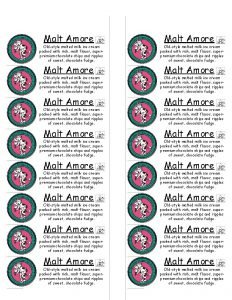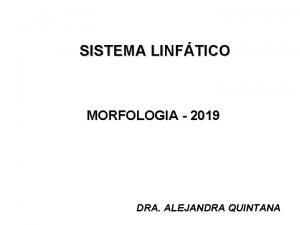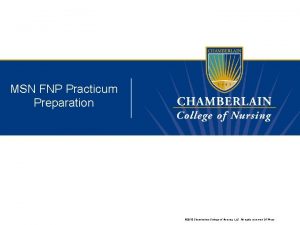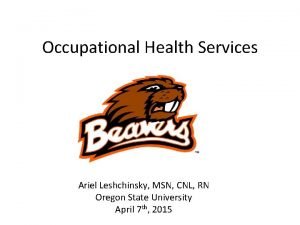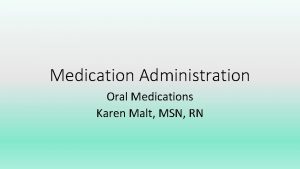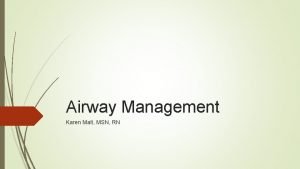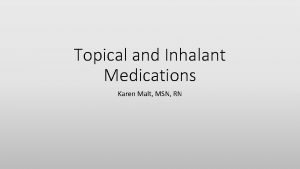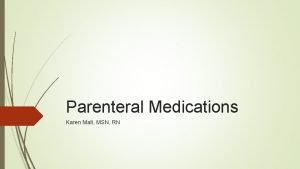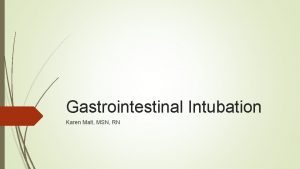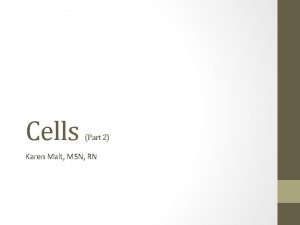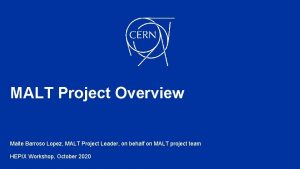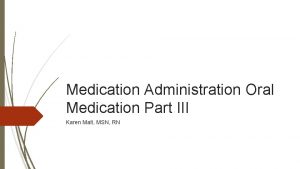z Karen Malt MSN RN Fundamentals of Oral



















- Slides: 19

z Karen Malt, MSN, RN Fundamentals of Oral Medications

Objectives z § Define Medication § Name the Seven Components of a Drug Order § Explain the Difference between Trade and Generic drug Names § Name Four Common Routes for Drug Administration § Describe the Oral Route and Two General Forms of Medication administered this way § Explain the Purpose of a Medication Record § Name three Ways that drugs are supplied § Discuss two nursing responsibilities that apply to the administration of opioids

z Objectives (continued) § Name the “Five Rights” of medication administration § Give the formula for calculating a drug dose § Discuss at least one guideline that applies to the safe administration of medications § Discuss one point to stress when teaching clients about taking medications § Explain the circumstances involved in giving oral medications by enteral tube and one commonly associated problem. § Describe three appropriate actions in the event of a mediation error.

z Introduction § Medication- Defined; Chemical substances that change body functions. § The term medications and drugs can and is used synonymously.

z Medication Orders § A “Medication Order” lists the drug name and directions for its administration. § Either Physician/Dentists provide Medication Orders either written or signed electronically via a secure computer system. § Depending by State Regulations, Advanced Practice Nurses and Physician’s Assistants can write medication orders.

z Components of a Medication Order § ALL Medication Orders MUST have Seven Components § 1. The client’s name § 2. The Date and Time the Order is written § 3. The Drug Name § 4. The Dose to be Administered § 5. The Route of Administration § 6. The Frequency of Administration § 7. The Signature of the Person ordering the drug NOTE: IF ANY OF THESE COMPONENTS ARE ABSENT FROM THE ORDER, THE NURSE MUST WITHHOLD ADMINSITERING THE DRUG UNTIL HE OR SHE HAS OBTAINED THE INFORMATION NECESSARY TO CARRY OUT THE ORDER.

z What’s Missing From this Mediation Order? St. Luke’s Manor § Mr. Donald Duck Digoxin 0. 125 mg daily Mary Jones, MD 8/25/16 3: 03 PM

z Drug Name § Trade Name (Brand Name or Proprietary Name) -The name by which a Pharmaceutical Company identifies its drug. § Generic Name (Chemical Name) § Example: Demerol (Trade Name) Meperidine Hydrochloride (Chemical Name). § NOTE: THE NCLEX EXAM IS USING GENERIC NAMES AND OMITTING TRADE NAMES IN THE CURRENT TEST PLAN.

z Look Alike and Sound Alike Drugs § Since 2014, the Joint Commission’s Medication Management Standards, requires hospitals to develop a list of look-alike sound alike medications it stores and dispenses, or administers to prevent mediation errors.

z

z Critical Thinking § Mrs. Jane Smith has terminal cancer. The chemotherapy has caused a decrease in her White blood cells, so the physician ordered Neulasta. The nurse assigned to her care administered Lunesta a drug used to enhance sleep instead of Neulasta. A facility incident report was filled out and all of the appropriate parties notified of the error. § What simple measures could have been taken to avoid this error?

z Drug Dose § Dose- The amount of drug to be given. The dose is administered using the metric system. Some drugs are also prescribed in units, milliunits, international units, and milliequivalents (m. Eq). This is a unique measurement used primarily for chemical compounds such as Potassium Chloride. § See Handout from Joint Commission; “Do Not Use Abbreviations”

z Route of Administration § How the Drug is Given or Administered § Oral § Topical § Inhalant § Parenteral

Route of Administration (continued) z § Oral Route- the administration of drugs by swallowing or instillation through the GI tract. § The most common route of administration, due to its safety, more economical, and more comfortable. § Drugs administered via oral route come in solid and liquid forms. § § Solid Medications; Tablets and Capsules § Scored Tablet – A groove for splitting in the center of the tablet § Enteric Coated Tablet; A solid drug covered with a coating that dissolves beyond the stomach. Enteric coated tablets are NEVER cut, crushed, chewed. § Sustained Release (SR) , or Extended Release (ER) (XL), or Continuous Release (CR) – These drugs are designed to be released slowly and over time. NEVER CRUSH this drug!!! Liquids – a form of an oral drug that includes syrups, elixirs, and suspensions. Nurses measure and administer liquid medications in calibrated cups, droppers, syringes, or with a dosing spoon.

z Effects of Reduced Organ Function on Drugs § Changes in organ systems directly affects drug absorption, drug distribution, drug metabolism, and drug excretion. § See Table 32: 3 Page 762 in Fundamentals Text (Timby, 2017).

z Frequency of Administration § Frequency- Refers to how often and how regularly the medication is to be given. § STAT – Immediately q 4 h – every 4 hours § b. i. d. – twice a day p. r. n. – as needed § t. i. d. – three times a day § q. i. d. – four times a day § q. h. – hourly NOTE; The facility will predetermine a timetable for drug administration, or hours of administration. For example; if a drug is ordered q. i. d, it may be given at 6 am, 12 N, 6 pm, and 12 MN.

z Verbal and Telephone Orders § Verbal Orders- Given during face-to-face conversation. § Telephone Orders- obtained from a physician during a telephone conversation. § NOTE; Both types of these orders are more likely to result in misinterpretation. § Review circumstances when a verbal/telephone order is justified. Page 762 Timby 2017.

z Obtaining Telephone Orders § Always Identify yourself, agency, and unit you are working. § Identify the client, situation, history, pertinent assessment, recommendation concerning care (SBAR). SBAR is the Joint Commission’s recommended practice for spoken communication among health care providers. § Verify the Identify of the prescriber with a callback telephone number. § Have another nurse listen on another line as a witness to the communication. § Record the date and time for the drug order exactly how it is received on the MAR (Medication Administration Record). § See Nursing Guidelines for Complete Details Table 32 -1 page 762 Timby (2017).

z Obtaining Telephone Order (continued) § 1. Make sure to include the essential components. § 2. Clarify or spell drug names especially those that sound similar § 3. Spell or repeat numbers to avoid miniterpretation such as 15 (one, five). § 4. Read back the written information § 5. Use the abbreviation T. O. at the end of the order § 6. Write the prescriber’s name and cosign with your name § 7. Remind the prescriber that the order must be signed ASAP according to the agencies policies.


